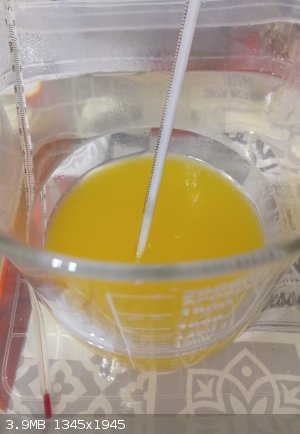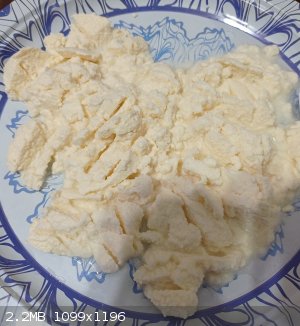DennyDevHE77
Hazard to Others
  
Posts: 148
Registered: 15-9-2014
Member Is Offline
Mood: No Mood
|
|
Causes of PETN yellowing
Recently I decided to prepare PETN again. Unfortunately, this time (loading pentaerythritol 200g) could not keep the temperature, as a result, instead
of the supposed 10-15C, at the end of the synthesis temperature rose to 30C, the mixture began to actively release nitrogen oxides and to avoid
oxidation, I poured the reaction mass in a bucket of water. That is, I did not carry out the next operation at 50C.
After neutralization, filtering, soda boiling, and filtering again I got the most usual very fine white powder. Same as always. But it still needed to
be recrystallized from acetone.
680ml acetone + 16g baking soda + 200g PETN.
Usually when recrystallizing (boiling) in acetone, the solution of PETN in acetone turns yellow. This was always the case (photo 1), but then when
PETN was diluted with water and filtered PETN became white.
This time even after rinsing with 10L of water PETN remained yellowish color (photo 2). I encountered this for the first time.
Does anyone have any suggestions to explain the reason for this yellowing? I searched the literature, but did not find anything. All of them had a
bright white powder after recrystallization from acetone.
The reagents used were of sufficient quality.
The pentaerythritol itself is >99% "pure" quality.
Sulfuric acid "Chemically pure" 95%
Nitric acid "Particularly pure for analysis" 70%
Technical acetone 99.75%. Previously, he did not cause any complaints.
[Edited on 26-10-2023 by DennyDevHE77]
 
|
|
|
Microtek
National Hazard
   
Posts: 828
Registered: 23-9-2002
Member Is Offline
Mood: No Mood
|
|
When the reaction releases NOx at lowish temperatures, it is a sign that the nitrc acid has begun to oxidize something. This must almost certainly be
the substrate (the PE). When organic molecules are oxidized like this, many time a conjugated system of double bonds is produced (probably along with
a wealth of other structures). These conjugated systems are seen as yellow or brown colorations. If you want to remove it, you could try dissolving
the product again and then treating the solution with activated carbon. This will usually cause the unsaturated compounds to adsorb to the carbon,
which is then filtered off.Then you crash out the PETN as usual.
[Edited on 27-10-2023 by Microtek]
|
|
|
DennyDevHE77
Hazard to Others
  
Posts: 148
Registered: 15-9-2014
Member Is Offline
Mood: No Mood
|
|
How much activated carbon do you need, for 350ml acetone + 100g PETN? And can't the charcoal also absorb the acetone solution of PETN itself?
And most importantly, is there much point in cleaning? More precisely, is it possible to guess at least approximately, how many of these colored
compounds there are. For me the purification is important for two reasons, stability of the product (long storage), and the highest power.
Regarding stability, my guess is that if these colored compounds have survived boiling soda solution, and boiling in acetone, they are probably stable
enough for long term storage.
It's the power that I'm worried about. Let's assume a PETN/PIB (85/15) plastic composition, such a plastic is quite workable. But if in this mixture
will be say 5% of these inert substances, I'm afraid it will affect the power.
[Edited on 27-10-2023 by DennyDevHE77]
|
|
|
Etanol
Hazard to Others
  
Posts: 138
Registered: 27-2-2012
Member Is Offline
Mood: No Mood
|
|
Try dilute the filtered aceton solution by ethyl or isopropil alcohol and cold it to 0C.
[Edited on 27-10-2023 by Etanol]
|
|
|
PLSHY
Hazard to Self
 
Posts: 88
Registered: 30-7-2023
Member Is Offline
|
|
Quote: Originally posted by DennyDevHE77  | How much activated carbon do you need, for 350ml acetone + 100g PETN? And can't the charcoal also absorb the acetone solution of PETN itself?
And most importantly, is there much point in cleaning? More precisely, is it possible to guess at least approximately, how many of these colored
compounds there are. For me the purification is important for two reasons, stability of the product (long storage), and the highest power.
Regarding stability, my guess is that if these colored compounds have survived boiling soda solution, and boiling in acetone, they are probably stable
enough for long term storage.
It's the power that I'm worried about. Let's assume a PETN/PIB (85/15) plastic composition, such a plastic is quite workable. But if in this mixture
will be say 5% of these inert substances, I'm afraid it will affect the power.
[Edited on 27-10-2023 by DennyDevHE77] |
You are right, lower quality petn will break down over time further
reducing power. Therefore, purification is very important. Purified petn can be stored for 40 years and still detonate normally. Regarding the
reason for the yellowing of petn, I also tried pouring it into the water after the nitrogen oxides came out (pgdn). This does make the nitrates
difficult to clean and I think the best thing to do is throw it away and start over! Uncontrolled nitrification, especially in the presence of
sulfuric acid, is a very complex reaction that may produce a large number of unstable by-products, condensation polymers. My batch of pgdn turned
green in less than two months after being washed with acetone and dozens of running water!
|
|
|
|